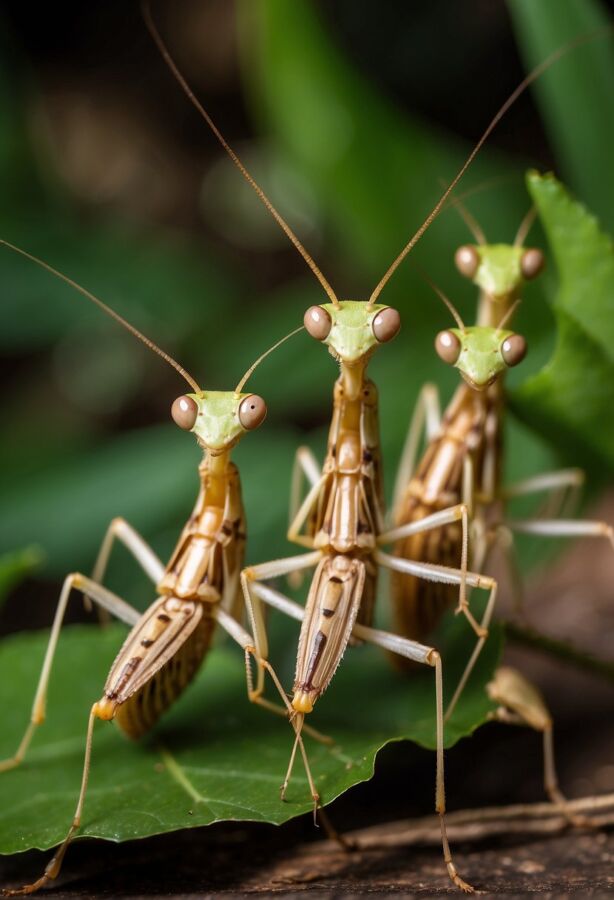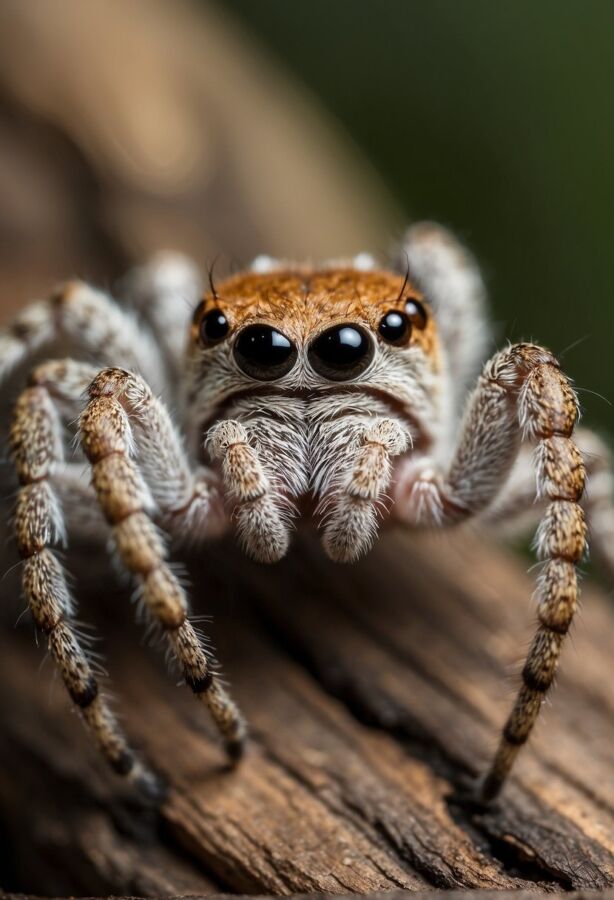Embark on an enthralling journey into the realm of creatures boasting more than a pair of eyes. Examine the iguana’s exceptional ability to sense predators, the praying mantis’s precision in striking its prey, and the distinctive visual systems of chitons and bees.
These animals utilize their complex eye structures to thrive in their environments. Explore the evolutionary benefits and sophisticated behaviors their multiple eyes enable, illustrating nature’s incredible versatility and creativity.
Iguanas

Iguanas, native to Central and South America, are a distinctive group of reptiles renowned for their third ‘parietal’ eye. Unlike their two primary eyes suited for clear vision, the parietal eye is rudimentary and sensitive primarily to changes in light.
- Appearance: The third eye appears as a pale scale on the top of the iguana’s head.
- Function: It helps regulate circadian rhythms and hormone production related to light and dark cycles.
- Evolution: This feature is an evolutionary adaptation, aiding in predator detection from above.
Iguanas share this trait with other lizard species, suggesting a deep-rooted evolutionary purpose among reptilian creatures. In young iguanas, this eye is more visible but becomes less discernible with age as it gets covered by scales. Despite its limited visual capability, the parietal eye plays a crucial role in survival, exemplifying the complexity of iguana anatomy.
Praying Mantis

The Praying Mantis belongs to the order Mantodea and is renowned for its distinctive hunting capabilities. Mantises are equipped with two large, compound eyes that enable acute vision, crucial for detecting the slightest movements of prey. These compound eyes are a mosaic of numerous ommatidia, each contributing to a portion of their visual field. This complex visual system facilitates precise predation.
Besides the prominent compound eyes, mantises possess three smaller ocelli—simple eyes located between the compound ones. These are thought to assist in perceiving light intensity and aiding in flight stabilization. The presence of these multiple eyes serves as an evolutionary advantage, positioning mantises as proficient hunters within their ecological niches.
Predators, in their own right, mantises deploy their raptorial forelegs in a swift snatch to capture unsuspecting insects. Their visual acuity allows them to time their strikes with high precision. Hence, the mantis’s ocular anatomy not only fulfills the role of locating prey but also underscores the mantis as an apex predator among insects.
With an affinity for stillness, mantises can remain motionless, blending into foliage, and ambush or actively pursue their quarry easily. The configuration and function of their eyes exemplify a remarkable adaptation to their predatory lifestyle.
Chiton

Chitons, marine animals found along rocky coastlines, possess an intriguing visual system integrated into their protective shells. Unlike most animals, a chiton’s eyes are not embedded in soft tissue; rather, they are distributed across its hard, calcified shell.
- Number of eyes: Up to 1,000 individual lens-and-retina-equipped eyes
- Shell function: Primarily protection and vision
Each eye, although seemingly simple in structure with a lack of cornea or iris, contains a miniature lens and retina. These optical components are crucial for forming images, allowing the chiton to discern predators and navigate its environment efficiently. Moreover, the eyes are resiliently compatible with its need for a rigid defense mechanism, an exemplary case of evolutionary adaptation.
The light-detecting capability of chiton eyes is less advanced than the human eye but is remarkably effective for the animal’s survival in dim marine habitats. The visual range extends to objects about 6 feet away, even in low-light conditions at the sea bottom. This ability to perceive surroundings while being shielded suggests a sophisticated balance between the necessity of protection and sensory perception.
Bees

Bees, pivotal pollinators in many environments, are insects known for their complex vision. Their eyes are split into two categories: compound eyes and simple eyes or ocelli. The compound eyes comprise numerous tiny lenses, providing a wide field of view vital for detecting flowers and avoiding predators. The ocelli, three simple eyes on the top of their heads, are light-sensitive, aiding bees to navigate and maintain stability during flight.
Visual Capabilities:
- Compound eyes: Mosaic image perception, motion detection
- Simple eyes: Light intensity assessment, circadian rhythm regulation
This sophisticated eye structure allows bees to gather food and contribute to their ecosystem through pollination effectively. Their vision, especially the ability to perceive ultraviolet light, optimally guides them to flowers rich in nectar and pollen, ensuring the survival of both the bee and the flowering plants they service.
See Related: Is Beekeeping Ethical?
Tuatara

The Tuatara, a native reptile of New Zealand, represents a unique branch of the reptilian family tree. Classified within the order Rhynchocephalia, these creatures were contemporaries of dinosaurs and have remained relatively unchanged for millions of years.
Anatomical Peculiarity:
- Third Eye: Also known as the parietal eye, this light-sensitive organ is located on top of the tuatara’s head. Although covered in scales and less developed, the eye possesses a rudimentary retina, lens, and cornea.
Functions of the Third Eye:
- Photoreception: Primarily assists in regulating circadian rhythms and hormone production.
- Predator Detection: May help in sensing aerial threats by detecting changes in light overhead.
Conservation Status:
Tuataras face threats from habitat loss and introduced predators, making conservation efforts in New Zealand critical for their survival.
Note on Physiology:
Despite their lizard-like appearance, tuataras are not lizards but the sole survivors of Rhynchocephalia, offering insights into reptilian evolution. Their two primary eyes afford them typical reptilian vision, while the brain processes varied sensory inputs, consolidating the tuatara’s remarkable sensory array.
See Related: The Longest Living Animals on Earth
Starfish

Starfish, known for their radial symmetry and marine habitat, possess an array of multiple eyespots at the tip of each arm. These eyespots, although simple in structure, are sensitive to light and aid the starfish in discerning movement, navigating the marine environment, and detecting predators. The eyespots are essentially small, pigmented areas that can detect changes in light intensity rather than forming clear images.
Anatomical Feature: Eyespots at each arm’s tip
Function: Sensitivity to light intensity
Advantages:
- Navigation through light detection
- Predator awareness
These eyespots are particularly crucial for the animal’s survival, giving them the evolutionary advantage of detecting and responding to numerous stimuli in their habitat. Starfish use these capabilities to seek out prey and avoid becoming prey themselves in the vast ocean.
See Related: Is a Fish an Animal?
Horseshoe Crab

The horseshoe crab, a marine arthropod, boasts a complex visual system with a total of 10 eyes distributed across its body. Each eye serves a distinct function, from navigating the environment to finding prey. Though often mistaken for crustaceans, horseshoe crabs are more closely related to arachnids.
Main Eyes: Their compound lateral eyes are the largest and are primarily used for locating mates during the breeding season. These eyes are incredibly sophisticated, containing up to 1,000 individual lenses that afford the crab a wide field of vision.
Secondary Eyes: Additionally, they possess median eyes that detect UV light and are believed to aid in synchronizing their circadian rhythms. The simple lateral eyes, though less complex, are crucial for sensing movement and orientation in murky water.
Tertiary Eyes: Horseshoe crabs are even equipped with a pair of rudimentary ventral eyes located near the mouth, aiding in navigation of the ocean floor. Their ability to detect both visible light and ultraviolet light allows them to thrive in fluctuating light conditions within their aquatic environment.
See Related: Animals That Start With X
Lamprey

The lamprey, an ancient lineage of jawless fish, inhabits various water environments. Often perceived as a predator due to its toothed, funnel-like mouth, the lamprey affixes itself to other fish to feed on their blood or tissue. These parasitic creatures are notable for their ocular anatomy; they possess a parietal eye—in addition to their main lateral eyes—that detects light variations overhead. This additional eye serves as an evolutionary advantage, assisting lampreys in navigating murky waters and evading potential threats from above.
| Main Eyes | Function |
|---|---|
| Lateral Eyes | Vision, prey detection |
| Parietal Eye | Light detection, predator avoidance |
Lampreys contribute to biodiversity but also face challenges from human activities that degrade their habitats. Understanding their unique visual system can inform conservation strategies to protect these exceptional animals and the delicate balance of their aquatic ecosystems.
Ogre-Faced Spider

Also known as net-casting spiders, the Deinopis genus comprises a group of spiders recognized for their unique hunting methods and nocturnal behavior. These spiders possess large, forward-facing eyes, which have evolved to adapt to their nighttime activities.
The ogre-faced spider’s predatory technique is noteworthy. Using their excellent night vision, they weave a small web that they hold with their legs, casting it over unsuspecting prey that wanders below.
The visual acuity of their primary eyes is so profound that it rivals the resolution of a cat’s vision at night. Each eye’s retina is incredibly sensitive to light, thanks to a high concentration of receptors, giving them an edge in the darkness. These spiders are not only remarkable in their anatomical adaptations but are also a testament to the evolutionary craftsmanship of nature.
See Related: What is a Six-Legged Spider?
Four-Eyed Fish

The Four-Eyed Fish (Anableps) is a unique animal that has evolved a specialized vision system. Although named for having “four eyes,” it possesses two eyes, each divided into separate parts by a band of tissue. This ocular adaptation allows it to see both above and below the water line simultaneously.
-
Eyes Structure: Each eye’s upper half is adapted for vision in the air, while the lower half is shaped for water vision.
Vision Function:
- Above Water: Detect predators and prey.
- Below Water: Monitor underwater activity.
-
Habitat: It thrives in freshwater and brackish water near the surface.
Four-eyed fish employ this bifurcated vision to avoid predators and hunt for prey, showcasing a remarkable evolutionary advantage that allows them to navigate their aquatic environment efficiently.
See Related: Fun and Interesting Devilfish Facts to Know
Triops

Triops, known as “living fossils,” are intriguing crustaceans that have survived from prehistoric times, retaining a body plan that has remained largely unchanged. Triops species thrive in various water environments, with a unique feature among many aquatic animals: they possess three eyes. Each eye is critical in helping these ancient creatures adapt to their ephemeral aquatic habitats.
The eyes include two compound eyes and a central naupliar eye, a primitive visual organ common to crustaceans. The compound eyes are adept at enabling spatial awareness and visual navigation, which is crucial for locating food and avoiding threats in their environment. The naupliar eye, although simpler in structure, assists in orienting the triops to light sources, which is essential for their survival and reproduction within their transient pools.
These adaptations allow Triops to exploit temporary water bodies that form in places like vernal pools and desert rain puddles efficiently. With rapid growth and a short life cycle, they make the most of these environments before evaporating. The remarkable design of their visual system ensures they remain a resilient species, successfully populating diverse aquatic niches across continents, from Africa to North America.
See Related: Blobfish Underwater vs Above Water
Jumping Spider

Jumping spiders, a diverse Arachnid group, are skillful hunters known for their acute vision. With eight eyes, these spiders have a pair of large, forward-facing eyes providing detailed, three-dimensional views of their surroundings. This binocular vision is crucial for precisely gauging distances when leaping onto prey. The lateral eyes are adept at detecting motion, effectively expanding the spiders’ field of view.
The smaller secondary eyes, though less powerful, play a vital role in navigation and predator detection. These multi-eyed predators predominantly hunt during daylight, combining their sharp vision with explosive speed and agility. At night, some species switch to a more sedentary hunting approach.
See Related: Best Books on Endangered Species
Opabinia

Opabinia regalis, a prehistoric creature of the Cambrian period, exhibits a unique anatomical structure. Particularly notable are its five eyes, which provided an evolutionary advantage for environmental awareness. This stem arthropod’s visual system might have been crucial for hunting and evasion in the complex ecosystems of the Burgess Shale.
The eyes of Opabinia were likely adept at detecting predators and prey, giving it a survival edge in its marine habitat. Its distinctive morphology underscores the adaptive nature of evolutionary processes in early complex organisms. Despite its alien-like appearance to modern observers, Opabinia’s anatomy reveals significant insights into the diversification of sensory abilities in early animal life.
